
Cucurbita pepo is a cultivated plant of the genus Cucurbita. It yields varieties of winter squash and pumpkin, but the most widespread varieties belong to the subspecies Cucurbita pepo subsp. pepo, called summer squash.
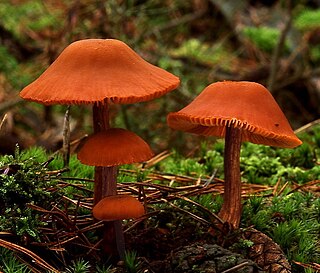
Laccaria laccata, commonly known as the deceiver, lackluster laccaria, or waxy laccaria, is a white-spored species of small edible mushroom found throughout North America and Europe. It is a highly variable mushroom, and can look quite washed out, colorless and drab, but when younger it often assumes red, pinkish brown, and orange tones. The species is often considered by mushroom collectors to be a 'mushroom weed' because of its abundance and plain stature.
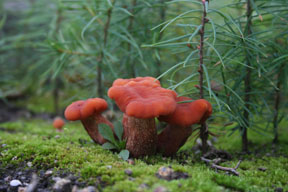
Laccaria bicolor is a small tan-colored mushroom with lilac gills. It is edible but not choice, and grows in mixed birch and pine woods. It is found in the temperate zones of the globe, in late summer and autumn. L. bicolor is an ectomycorrhizal fungus used as a soil inoculant in agriculture and horticulture.

Laccaria is a genus around 75 species of fungus found in both temperate and tropical regions of the world. They are mycorrhizal. The type species is Laccaria laccata, commonly known as the deceiver. Other notable species include L. bicolor, and the amethyst deceiver (L. amethystina), sometimes incorrectly written as L. amethystea. Because some Laccaria species have the ability to grow vegetatively and/or germinate from basidiospores in culture, they are often used as experimental systems for studies of ectomycorrhizal basidiomycetes. They have a tetrapolar mating system, meaning that there the mating type is controlled by 2 loci. Recently, the genome of L. bicolor has been sequenced.

Stagmomantis is a genus consisting of 21 species of mantises native to the Americas.
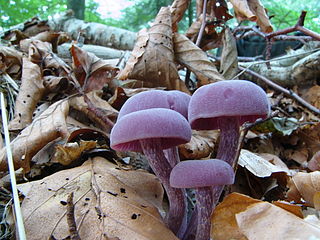
The Hydnangiaceae are a family of fungi in the mushroom order Agaricales. Widespread in temperate and tropical regions throughout the world, the family contains about 30 species in four genera. Species in the Hydnangiaceae form ectomycorrhizal relationships with various species of trees in both coniferous and deciduous forests.

Laccaria amethystina, commonly known as the amethyst deceiver, or amethyst laccaria, is a small brightly colored mushroom, that grows in deciduous and coniferous forests. The mushroom itself is edible, but can absorb arsenic from the soil. Because its bright amethyst coloration fades with age and weathering, it becomes difficult to identify, hence the common name "deceiver". This common name is shared with its close relation Laccaria laccata that also fades and weathers. It is found mainly in Northern temperate zones, though it is reported to occur in tropical Central and South America as well. Recently, some of the other species in the genus have been given the common name of "deceiver".
Ammonia fungi are fungi that develop fruit bodies exclusively or relatively abundantly on soil that has had ammonia or other nitrogen-containing materials added. The nitrogen materials react as bases by themselves, or after decomposition. The addition of ammonia or urea causes numerous chemical and biological changes, for examples, the pH of soil litter is increased to 8–10; the high alkaline conditions interrupts the process of nutrient recycling. The mechanisms of colonization, establishment, and occurrence of fruiting bodies of ammonia fungi has been researched in the field and the laboratory.
Dingana fraterna, the Stoffberg widow, is a butterfly of the family Nymphalidae. It is only known from one hillside to the south-west of the Stoffberg in the Mpumalanga province.

Laccaria amethysteo-occidentalis is a mushroom found under conifers, usually pine, growing alone, scattered or gregariously in western North America.

Diastella is a genus containing seven species of flowering plants, commonly known as “silkypuffs”, in the protea family. The name comes from the Greek diastellein “to separate”, with reference to the free perianth lobes – the plants are distinguished from the closely related and similar leucospermums by the possession of four free perianth segments. The genus is endemic to the Cape Floristic Region of South Africa where it has a very limited range and is associated with fynbos habitats. The species are all small shrubs. Most species are threatened.
Phalonidia fraterna is a species of moth of the family Tortricidae. It is found in China, Korea and Russia.

4-Hydroxybenzoic acid 4-O-glucoside is a glucoside of p-hydroxybenzoic acid. It can be found in mycorrhizal and non-mycorrhizal roots of Norway spruces.
Clepsis fraterna is a species of moth of the family Tortricidae. It is found in Ecuador in the provinces of Loja and Morona-Santiago.

Ctenopseustis fraterna, the brownheaded leafroller or the rusty ponga leaf-tyer, is a species of moth of the family Tortricidae. It is found in New Zealand, where it has been recorded from the North Island only. The common name is also used for the related species Ctenopseustis herana and Ctenopseustis obliquana.
Ericeia fraterna is a moth in the family Erebidae. It is found in China, India, Burma, Sri Lanka, the Philippines (Luzon) and Indonesia.
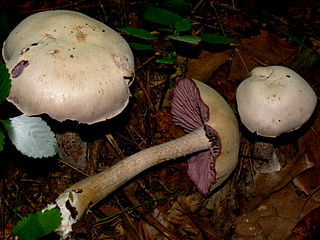
Laccaria ochropurpurea is an edible mushroom found under hardwood and conifers east of the Rocky Mountains. The pileus ranges from 4–13 centimetres wide and the stipe from 5–19 centimetres long.

Nososticta fraterna is an Australian species of damselfly in the family Platycnemididae, commonly known as the northern threadtail.
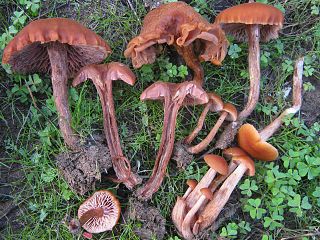
Laccaria proxima is a species of edible mushroom in the genus Laccaria from the conifer forest of California, as well as eastern and northern North America.














